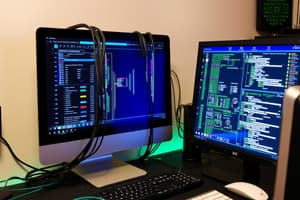Podcast
Questions and Answers
When discussing network topologies what is the main difference between a LAN and a PAN?
When discussing network topologies what is the main difference between a LAN and a PAN?
- A PAN is a private network used only by a single person, while a LAN can be shared by multiple people. (correct)
- A LAN is a personal area network.
- A LAN typically connects devices in close proximity, while a PAN covers a wider area.
- A PAN is a large network that often spans a city.
What is the purpose of a device driver?
What is the purpose of a device driver?
- To manage the flow of data between the CPU and memory.
- To protect the computer from unauthorized access.
- To allow communication between the operating system and a specific hardware device. (correct)
- To translate machine language into instructions that the CPU can understand.
What is the difference between RAM and ROM?
What is the difference between RAM and ROM?
- RAM is volatile memory, meaning data is lost when the power is off, while ROM maintains data even when off. (correct)
- RAM is used for program instructions, while ROM stores user data files.
- ROM is a type of solid-state drive, while RAM is a type of magnetic storage.
- ROM is used to store temporary data, while RAM stores permanent data.
What is the main purpose of a server in a computer network?
What is the main purpose of a server in a computer network?
Which type of storage uses a laser to read and write data?
Which type of storage uses a laser to read and write data?
Flashcards
ASCII
ASCII
A character encoding standard for text in computers.
Bandwidth
Bandwidth
The maximum rate of data transfer across a network.
MAC address
MAC address
A unique identifier assigned to network interfaces for communications.
IPv4 & IPv6
IPv4 & IPv6
Signup and view all the flashcards
Compression Types
Compression Types
Signup and view all the flashcards
Study Notes
Exam Topics
- Chapters 1-3 are required reading material
- Electronic devices are not permitted during the exam.
- A scantron is required for the exam.
Acronyms
- AAC
- ALU
- ARPANET
- ASCII
- Bandwidth
- Binary
- BMP
- BN
- Broadband
- CISC
- Compression Types
- Core
- CPU
- Data Bus
- Device Driver
- DNS spoofing
- Dynamic Address
- Form Factor
- GIF
- Handshake
- IPv4 & IPv6
- JPEG
- LAN
- Laser Printer
- LCD
- LED
- MAC address
- Machine Language
- Magnetic Storage
- MAN
- Microprocessor Clock
- MIDI
- MPEG
- Network Topology
- Niche Device
- OCR
- Operating System
- Optical Storage
- Packet
- PAN
- Pixelization
- PNG
- RAM
- RAW
- RFID
- ROM
- Sampling Rate
- Server
- Solid State Drive
- System Unit
- TCP
- TIFF
- Top-Level Domain
- USB
- Vector Graphic
- Virtual Memory
- WAN
- WAV
- WEP
- WiFi
- WMA
- Word Size
Studying That Suits You
Use AI to generate personalized quizzes and flashcards to suit your learning preferences.




